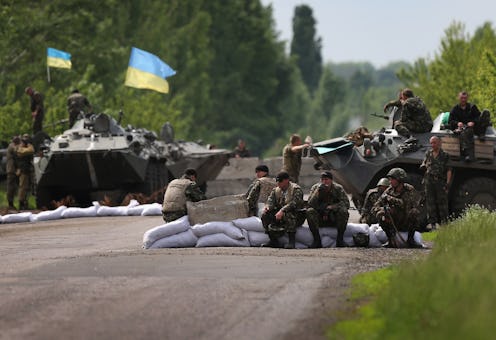News
Did Russia Just Invade Ukraine... Again?
On Wednesday morning, NATO officials reported sightings of Russian military equipment crossing into Ukrainian borders; artillery was fired in the rebel-held city of Donetsk. NATO's supreme allied commander, U.S. Gen. Phillip Breedlove told Agence France-Presse that he had seen "Russian equipment, primarily Russian tanks, Russian artillery, Russian air defense systems and Russian combat troops entering into Ukraine."
The Russian equipment sightings and violence in Donetsk suggest an end to the ceasefire that Ukraine and its pro-Russia separatists had signed in September. And now Russian officials have reportedly announced plans to send a seventh convoy into Ukraine, amid speculation that the Kremlin was continuing to arm the separatist rebels.
NATO's Wednesday report is just the latest in a string of similar warnings made over the last few days by the White House, the Organization For Security and Cooperation in Europe (OSCE), and Ukrainian officials, who all claim that Russia is brewing a new offensive in Ukraine near the Russian border. On Monday, Ukrainian President Petro Poroshenko told Vice President Joe Biden that Russia had moved heavy military equipment into Ukraine's eastern region, where pro-Russia separatists hold court. And on Tuesday, Ukrainian Ambassador to the U.S. Yuriy Sergeyev tweeted that Russia had doubled the supplies to the rebels, and even hinted at the possibility that Russia has installed nuclear weaponry in Ukraine. He warned that a Russian invasion was imminent if not already a reality.
Though Major-General Igor Konashenkov, the official spokesman for the Russian Defense Ministry, has denied these allegations, Russia has certainly provided more than enough evidence of its invasion. Like Gen. Breedlove, the OSCE reported Tuesday that its officials had seen a convoy of 43 unmarked military trucks moving into Donetsk. According to the OSCE, five of the trucks were carrying 120mm howitzer artillery pieces and another five were transporting multi-launch rocket systems. On the same day, Ukraine's Border Guard Services reported seeing more than 100 Russian armored vehicles crossing into Ukraine the day before.
All of this suggests that the ceasefire, which was signed in Minsk, Belarus on September 5 and was brokered by the OSCE, is nothing more than a fading concept. The pact was fraught with problems from the start. Just hours after it was signed, pro-Russia separatists accused Ukrainian government forces of violating the truce and vowed to keep pursuing their control of the east. Since then, accusations have flown back and forth, but most have been made by Ukraine against rebels as they made good on their promise to continue attacking government forces. The last two months have seen intensified fighting, including near the airport in Donetsk, killing a total of about 400 people since the ceasefire was signed.
Image: Getty Images
